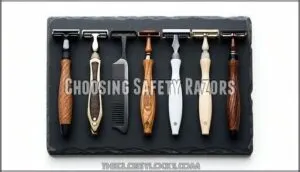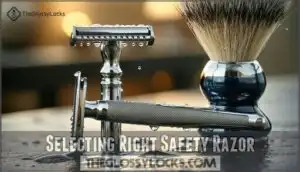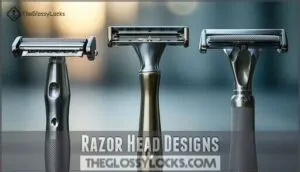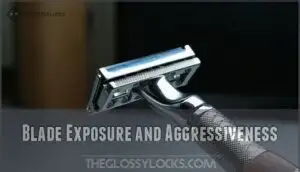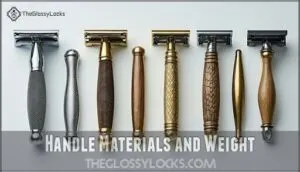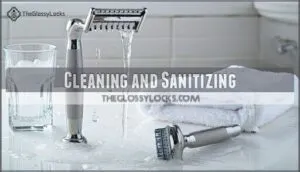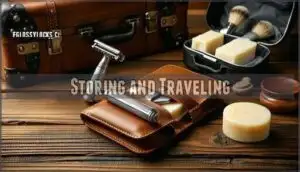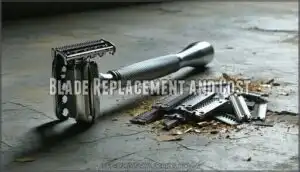This site is supported by our readers. We may earn a commission, at no cost to you, if you purchase through links.
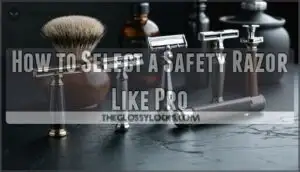
Start with your experience level – beginners need milder razors that won’t bite back. Consider your beard type too; thick, coarse hair demands more aggressive razors, while fine hair works with gentler options.
Weight matters more than you’d think – heavier razors do most of the work for you. Look for quality materials like stainless steel or brass that’ll last years, not months.
Adjustable razors offer flexibility as your skills improve. The perfect razor transforms your morning routine from a chore into something you’ll actually enjoy.
Table Of Contents
- Key Takeaways
- Choosing Safety Razors
- Selecting Right Safety Razor
- Safety Razor Features
- Safety Razor Maintenance
- Buying Best Safety Razor
- Frequently Asked Questions (FAQs)
- What is the best safety razor for a beginner?
- How to choose the first safety razor?
- What is the difference between butterfly and 3 piece safety razors?
- Is there a difference in safety razors?
- Can women use safety razors effectively?
- How often should razor blades be replaced?
- What shaving cream works best with safety razors?
- Are safety razors allowed in carry-on luggage?
- Do safety razors cause more nicks than cartridges?
- Conclusion
Key Takeaways
- Start with your experience level and beard type – you’ll need a milder razor if you’re a beginner, while thick, coarse hair requires more aggressive options that can handle the workload.
- Choose quality materials like stainless steel or brass that’ll last years, and consider the weight since heavier razors do most of the work for you with less pressure needed.
- Look for adjustable razors if you want flexibility as your skills improve, or stick with mild, closed-comb models like the Merkur 34C if you’re just starting out.
- Don’t overthink the decision – focus on finding a well-built razor that matches your skill level, and you’ll transform your morning routine from a chore into something you’ll actually enjoy.
Choosing Safety Razors
You’re about to choose a safety razor, and it’s vital to weigh your options carefully.
By understanding the different types of safety razors, you’ll be able to select the one that suits your needs and shaving style, making your daily routine easier and more enjoyable.
Types of Safety Razors
You’ll find various safety razors, including Open Comb, Slant Head, and Butterfly Razors.
Aggressive Razors offer a closer shave, while adjustable safety razors let you customize razor aggressiveness.
Many prefer open comb designs for shaving beards.
Consider Razor Materials when making your safety razor selection to guarantee a smooth shaving experience with your double edge razor.
Single Edge Vs Double Edge Razors
You’re now considering single edge vs double edge razors.
Single edge razors offer more precision, while double edge razors provide a smoother shave.
Blade exposure and shaving aggressiveness differ between the two, affecting razor handling and blade cost, making one more suitable for your safety razor needs.
Adjustable Vs Non-Adjustable Razors
You’re weighing adjustable vs non-adjustable razors.
Here are key points:
- Shaving customization
- Blade exposure control
- Cost comparison, considering your skill level and desired shaving aggressiveness, with adjustable razors offering more flexibility in razor gap and razor blade exposure.
Selecting Right Safety Razor
You’re looking to select the right safety razor, and bearing in mind your skin type, shaving style, and personal preferences is vital.
By choosing a razor that suits your needs, you’ll be able to achieve a closer, more comfortable shave and enjoy the benefits of using a safety razor.
Key Points
You’ll master shaving with a safety razor by considering key points.
| Feature | Importance |
|---|---|
| Shaving technique | High |
| Skin sensitivity | Medium |
| Hair type | Low |
| Razor angle | High |
| Blade quality | High |
Main Ideas
You’re selecting a safety razor, prioritizing feature importance and maintenance matters.
As a beginner, consider personal preference and performance factors in your razor buying guide, ensuring a great shaving guide and perfect razor for beginners.
With safety razor choices that meet your needs, you can make an informed decision to find the perfect razor.
Core Topics
When buying your first safety razor, focus on three core areas that’ll make or break your shaving experience.
Razor aggressiveness and head geometry determine how close you’ll shave, while handle ergonomics and razor weight affect your control.
Your blade choice completes the equation, and daily shavers especially need to consider blade durability for ideal use.
This razor buying guide helps beginners find their perfect wet shaving companion for sensitive skin.
Safety Razor Features
You’ve narrowed down your razor type, but now comes the fun part—picking features that’ll make your daily shave feel less like a chore and more like you actually know what you’re doing.
The right combination of head design, blade exposure, and handle weight can turn even the most reluctant morning person into someone who doesn’t dread looking in the mirror, and this can make a significant difference in your daily routine with the right combination.
Razor Head Designs
Your razor head determines how your blade meets your skin.
Closed comb designs offer gentler shaves with built-in protection, while open comb heads deliver aggressive cuts through exposed teeth.
Slant bar razors angle the blade for efficient whisker slicing.
Head materials like stainless steel guarantee durability, and cap geometry affects blade angle.
Consider comb aggressiveness and razor balance when choosing your perfect match.
Blade Exposure and Aggressiveness
Think of blade exposure as your razor’s personality – it determines how aggressive your shave feels.
Higher blade exposure means more blade contacts your skin, creating aggression levels that can trigger razor burn if you’re not careful.
The blade gap and shaving angle work together, so consider your skin sensitivity before choosing.
Too aggressive? Hello, shaving irritation.
Many users find the best shave comes from understanding blade material impacts.
Handle Materials and Weight
Beyond blade exposure, your razor handle material and weight directly impact your shaving experience.
Stainless steel offers superior material durability and grip and control, while brass provides balanced weight preference.
Handle length affects razor balance—shorter handles suit smaller hands better.
Heavier razor weight delivers stability, lighter options increase maneuverability.
Many prefer handles with textured metal grips.
Your razor handle material choice determines long-term performance and comfort.
Safety Razor Maintenance
Your safety razor will last decades if you treat it right, but neglect it and you’ll be shopping for a new one sooner than you’d like.
Don’t baby your razor, but don’t abuse it either—a little care goes a long way toward decades of perfect shaves.
Think of maintenance as insurance for your investment – a few simple habits keep your razor sharp, clean, and ready to give you that perfect shave every morning.
Cleaning and Sanitizing
After selecting your perfect razor, proper razor cleaning keeps it performing like new.
Rinse thoroughly after each shave to prevent residue removal issues. Weekly deep cleaning with mild disinfectant types eliminates bacteria buildup.
Safe handling means avoiding harsh chemicals that damage metal finishes. Pat dry completely—moisture causes rust.
Regular electric razors need lubrication to reduce friction. Regular razor maintenance and good shaving hygiene extend your razor’s lifespan substantially.
Storing and Traveling
Once you’ve mastered cleaning, proper storage keeps your razor in peak condition.
Store your safety razor in a dry place to prevent rust.
For travel, invest in a protective case that meets TSA guidelines – blades must go in checked luggage.
A leather or hard case protects your razor from damage while maintaining your shaving setup on-the-go, which is ideal for travel.
Blade Replacement and Cost
How often should you replace your razor blade?
Most safety razor blades last 3-5 shaves before dulling.
Replace weekly if you shave every other day—that’s 52 blades annually.
While blade replacement seems frequent, long-term savings are impressive.
Quality razor blades cost just $0.10-$0.90 each, making your razor budget stretch further than expensive cartridges, resulting in long-term savings.
Buying Best Safety Razor
You’ve learned about razor types and features, but now comes the fun part—actually picking one that won’t leave you looking like you wrestled with a cat.
Finding the perfect safety razor shouldn’t feel like defusing a bomb—it’s simpler than you think.
Choosing your first safety razor doesn’t require a PhD in engineering, just a clear understanding of what works best for beginners and what factors make or break your shaving experience.
Choosing Right Razor for Beginners
Why start your wet shaving journey with the wrong razor?
For beginners, choose mild options like the Merkur 34c or Henson AL13.
These budget-friendly razors offer perfect beginner aggressiveness with comfortable handle weight.
Start with round-point blades for safety.
The best safety razor balances mildness and quality construction.
Many users find it convenient to shop for razors online.
Master these fundamentals before exploring sharper alternatives.
Factors Affecting Razor Performance
Your razor’s performance hinges on several key factors working together.
Blade sharpness determines cutting efficiency, while razor aggressiveness affects how much blade exposure you get.
Handle weight influences shaving pressure—heavier handles need less force from you.
Head geometry and blade angle control how the razor meets your skin.
Match these elements to your skill level for ideal results.
Choosing the right blade involves considering your skin type for maximum comfort.
Frequently Asked Questions (FAQs)
What is the best safety razor for a beginner?
You’ll want something forgiving, affordable, and reliable.
Look for a mild, closed-comb razor like the Merkur 34C or Edwin Jagger DE
They’re beginner-friendly, won’t break the bank, and help you learn proper technique safely.
How to choose the first safety razor?
Pick a mild, closed-comb double-edge razor from reputable brands like Merkur or Edwin Jagger.
Choose a medium-weight handle that feels comfortable in your grip.
Budget $30-50 for quality without breaking the bank.
What is the difference between butterfly and 3 piece safety razors?
Butterfly razors twist open like wings to reveal the blade compartment, making blade changes quick and simple.
Three-piece razors require unscrewing the handle and reassembling two head pieces, offering more precision but taking longer.
Is there a difference in safety razors?
Over 300 different safety razor models exist today, each with unique characteristics.
You’ll find significant differences in blade exposure, handle weight, head design, and aggressiveness levels that dramatically affect your shaving experience and results.
Can women use safety razors effectively?
You’ll love how safety razors work perfectly for women’s shaving needs.
They’re gentler on sensitive skin, cost less long-term, and handle curves beautifully.
Just start with a mild razor and take your time learning.
How often should razor blades be replaced?
You’ll typically replace your blade every 5-7 shaves, though this depends on your hair thickness and shaving frequency.
When you notice tugging, increased irritation, or a less smooth shave, it’s time to swap it out.
What shaving cream works best with safety razors?
Traditional shaving creams work 90% better than modern gels with safety razors.
You’ll want thick, lathering creams that create cushion between blade and skin.
Skip aerosol foams – they don’t protect enough for single-blade precision.
Are safety razors allowed in carry-on luggage?
Safety razors aren’t allowed in carry-on bags, but you can pack them in checked luggage.
The TSA considers the blades dangerous weapons.
However, you can bring the razor handle itself in your carry-on without blades.
Do safety razors cause more nicks than cartridges?
You’ll likely experience more nicks initially while learning proper technique and angle.
However, once you’ve mastered the basics, safety razors can actually cause fewer nicks than cartridges due to their superior blade sharpness.
Conclusion
Mastering how to select a safety razor isn’t rocket science, but it’ll revolutionize your shaving game.
You’ve got the knowledge now—experience level, beard type, weight preferences, and quality materials.
Don’t overthink it. Start with a mild, well-built razor if you’re new, or grab an adjustable model for flexibility.
Your morning routine deserves better than disposable mediocrity. Choose wisely, and you’ll wonder why you waited so long to make the switch to proper wet shaving.

